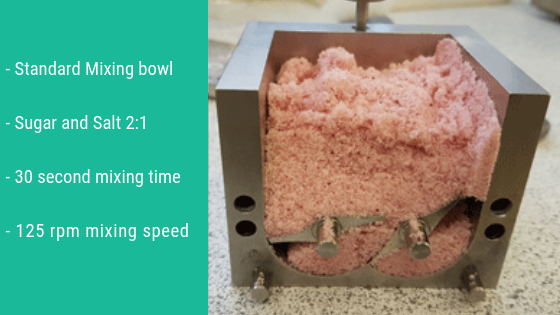
We are frequently asked for information about the ability of the small mixer/granulator/blender, a must have tool for any laboratory needing to complete these processes quickly with small sample sizes. Recent trials provide new information about the capability of the Caleva mixer/granulator/blender (MGB) and its ability to act as a stand alone mixer when mixing powder samples of different sizes and weights.
In this experiment, we tested different mixing bowls, products and mixing times to get a variety of results demonstrating the flexibility of the Caleva mixer/granulator/blender.
Mixing bowls
The MGB is offered with two types of mixing bowl. Standard mixing bowls are available in full and reduced sizes. All bowls are available with and without water jackets. A water jacket can be useful when you wish to add or remove heat from, the mixing chamber.
Standard bowl: The standard bowl has an internal volume of 275 ml. The reduced height bowl has a volume of 71 ml. The contra-rotating blades running at different speeds are designed to impart shear on the product during the mixing and granulating process. This property can be useful in many circumstances and this is the standard option for most products.
Sigma blade and bowl system: A second option is a bowl and blade system where the blades do not overlap (but do rotate at different speeds). This system is designed for situations where greater emphasis is required for the mixing component of the process and less emphasis on the level of shear required. This bowl and blade set is particularly useful when working with higher viscosity materials.
The Sigma blade bowl system is available in full size.
This system can be particularly useful for mixing products that are more difficult to work with.
Products tested
Two different products were tested to help a customer who was having difficulty in obtaining homogeneous mixes of small volumes of material that were considered difficult to mix well in the very small batch size required.
Product 1– Trial 1
A mix of sugar and salt in the ratio 2:1
A batch of 100 g of household sugar was weighed and added to the mixing bowl, together with a batch of 50 g of table salt. A full-sized standard bowl without an insert was used. Inserts can be useful when very small quantities are required to be mixed but in this case it was not necessary.
This batch was mixed for about 30 seconds at 125 rpm and it appeared that with this particular mix (with a tapped bulk density of 1.35) the mixing process worked but was not optimum. This batch size was a little too big to achieve very effective mixing quickly.
A 25 g sample was removed from the mixing chamber and the remaining batch of 125 g was sufficiently mixed within about 30 seconds using a mixing speed of 125 rpm. These observations were by eye. In order to make a visual inspection easier 0.4 ml of an aqueous food dye was added to the sample. The sample was mixed for an additional 30 seconds at 125 rpm.
The qualitative results shown in the pictures below indicate that a thorough mix is achieved with samples using a mix time of about 90 seconds. In the photograph below the mixing bowl is removed from the multi lab and the front plate is removed from the mixing bowl. This allows a qualitative visual inspection of the mix.
Product 1 – Trial 2
In a 2nd trial with the same material the Sigma blade system was used. In this case the mixing was effective but less efficient (it was mixing but was taking longer). The picture below shows the mixed state in the Sigma bowl after 90 seconds. It is believed that the eventual effectiveness of the mixing would be equal to that of the standard blade set but in this case a longer mixing time would be required.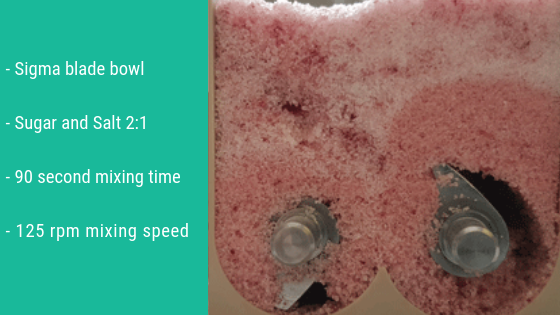
Product 2 - Trial 1
In a 2nd set of trials an attempt was made to mix a fine oat bran (tapped bulk density 0.54) with a “room temperature solid” palm oil with a melting point of about 80°C.
The standard bowl and blades were used as the shear activity was considered important in case the palm oil began to solidify before being fully dispersed.
The optional water jacket bowl was not available and thus not used (generally this would be recommended in such a case). The bowl was heated before use by immersion in hot water (at about 80°C).
A sample 50 g of oat bran was added to the mixing bowl and the mixer run at 150 rpm. The very low bulk density oat bran 50 g batch was added to the mixer and it was already full. A batch of 10 g was removed from the mixer and the mixing activity was good. A 5 ml sample of liquid palm oil (heated in a water bath to approximately 80°C) was taken into a syringe and quickly added to the sample being mixed. The mixer was run at 150 rpm for 10 minutes.
After 10 minutes the resulting mixture had the appearance of being completely homogeneous. The fully blended - but now solidified oil - caused the visible colour change which appeared homogeneous throughout the sample.
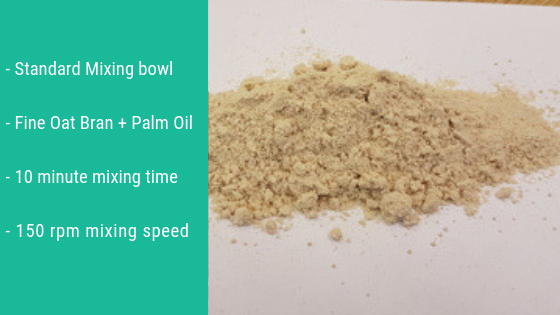
Product 2 - Trial 2
In the 2nd trial the amount of oil added to the 40 g of oat bran was increased to 8 ml. The oil was added to the mix in 2×4 ml lots with the mixer running at 150 rpm.
With the higher quantity of palm oil, and after 10 minutes, there was some sticking of material on the mixing blades. This material was scraped from the blade and the material was mixed for an additional 2 minutes at 240 rpm. The additional mixing removed the small amount of material and the mix was homogeneous. In practice, this additional 2nd mixing is a reasonable step in the few instances that it may be required.
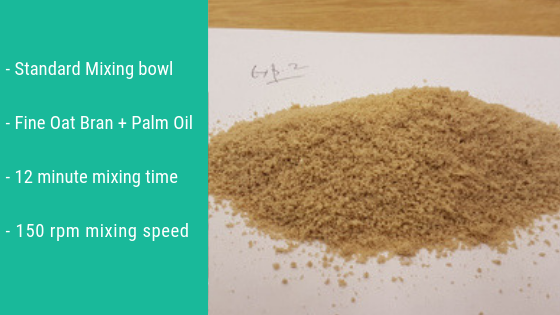
Product 2 - Trial 3
In a final trial, 40 g of fine oat bran was mixed with 2 ml of palm oil for 10 minutes at 240 rpm. This smaller quantity mixed effectively and the resulting mixture was again homogeneous as shown below.
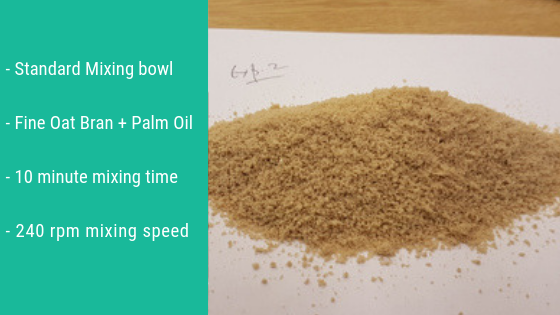
Conclusions
- The Caleva MGB gives excellent performance as a standalone mixer when distributing small amounts of liquid through a fine powder matrix.
- It gives excellent performance as a standalone mixer when mixing powder samples of different size and weight.
- The amount of the powder component that can be mixed in a single batch is dependent on the bulk density of the product. In the reported trials, using a product with a bulk density of 1.35, a batch of 125 g can be mixed effectively. With a product with a bulk density of 0.54, a batch of 40 g was effectively mixed.
- Oil can be effectively mixed even if the oil is a solid at room temperature. A water jacketed bowl would be an advantage and should be considered.
- A range of bowl sizes and blade designs are available and the most appropriate can be chosen depending on the properties of the materials to be mixed or granulated. Contact Caleva for additional advice using the Online Chat in the bottom right hand of the screen.


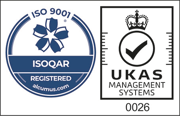
Leave A Comment